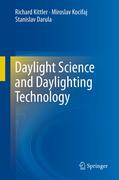
Daylight science and daylighting technology
Kittler, Richard
Kocifaj, Miroslav
Darula, Stanislav
Sunlight profoundly influences the Earth's atmosphere and biosphere. Nature fuels the evolution of all living things, their visual systems, and the manner in which they adapt, accommodate, and habituate. Sun luminance measurements serve as data to calculate typical changes in the daily, monthly, and annual variability characteristics of daylight. Climate-based sky luminance patterns areused as models in predicting daylighting calculation and computer programs applied in architecture and building design. Historically, daylight science and daylighting technology has prioritized photometric methods of measurements, calculation, and graphical tools aimed at predicting or evaluating the daylighting of architectural design alternatives. However, due to a heightened awareness of general health and well-being, sunlight exposure and freedom from visual discomfort while undertaking visual tasks are now equally prioritized. Therefore, in order to assure optimal environmental quality, daylighting technology must be based on sound science. Daylight Science and Daylighting Technology , by Richard Kittler, Miroslav Kocifaj, and Stanislav Darula, sketches the entireevolution of daylight science from atmospheric science through apt visual workplace psychophysics. Written by a leading authority on sky model formulation and daylight measurement. Includes information on non-overcast skies and year-round situations important for energy saving calculations, not included in other books. Includes a historical overview of advancements and developments in human vision and photonic studies. Analyzes recent research trends in daylight illumination technology in improving health and comfort in human environments.Refines daylight theory and introduces new calculation methods and computer tools for programs such as window design MAM and novel hollow light guides HOLIGILM. INDICE: Preface. Introduction. Short historical review of daylight utilisation by living creatures. Daylight photometry: history, principles and empirical development. Propagation of light in the atmospheric environment. Sky luminance characteristics. Possibilities to simulate year-round changes of the local daylight climate. Fundamental principles for daylight calculation methods. Analytical calculation methods and tools for the design of un-glazed apertures.Daylight methods and tools to design glazed windows and skylights. Modelling daylight distribution in complex architectural spaces. The neurophysiology andpsychophysics of visual perception. Discomfort and disability glare in the visual environment. Index.
- ISBN: 978-1-4419-8815-7
- Editorial: Springer New York
- Encuadernacion: Cartoné
- Páginas: 405
- Fecha Publicación: 28/09/2011
- Nº Volúmenes: 1
- Idioma: Inglés
